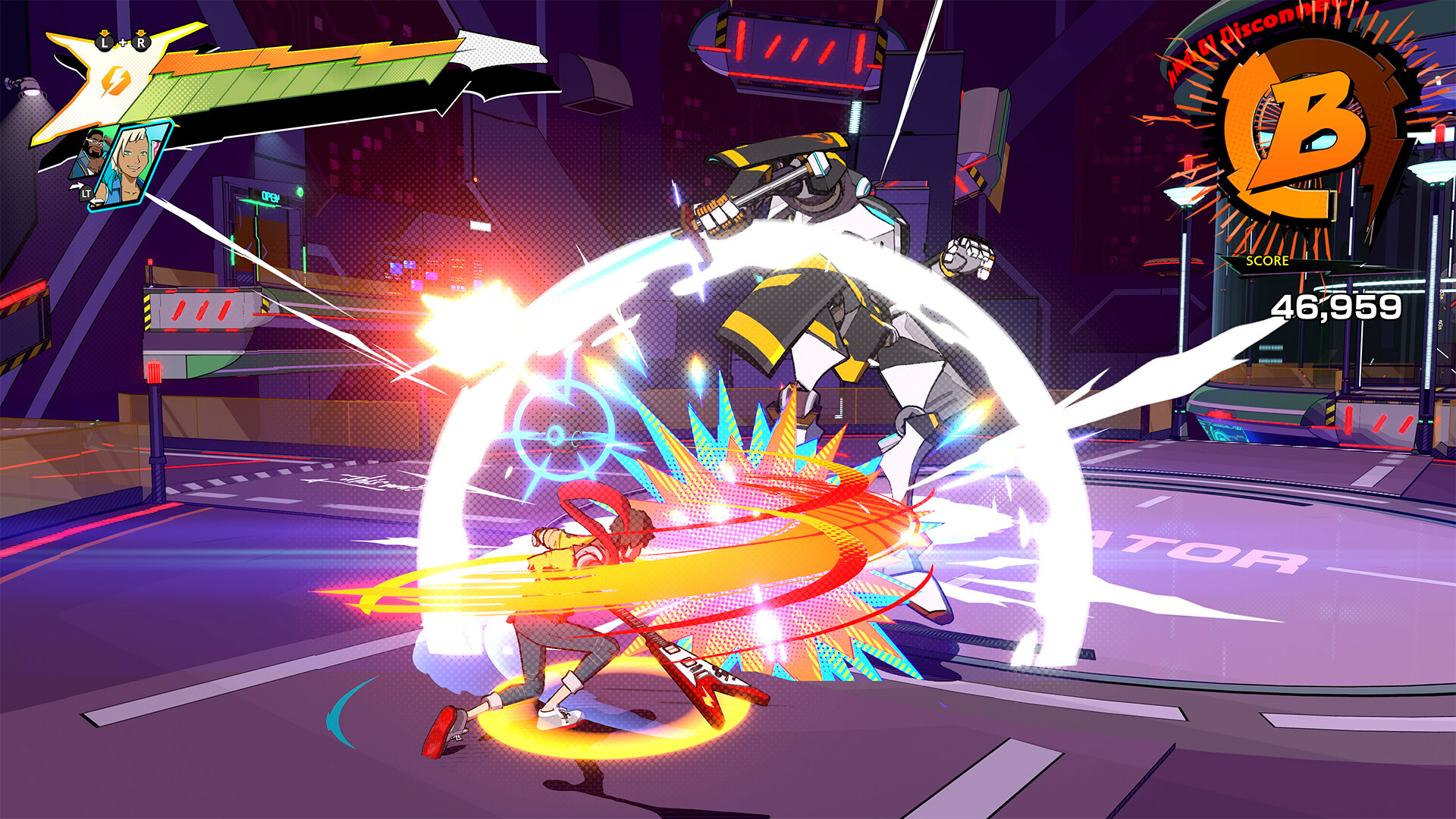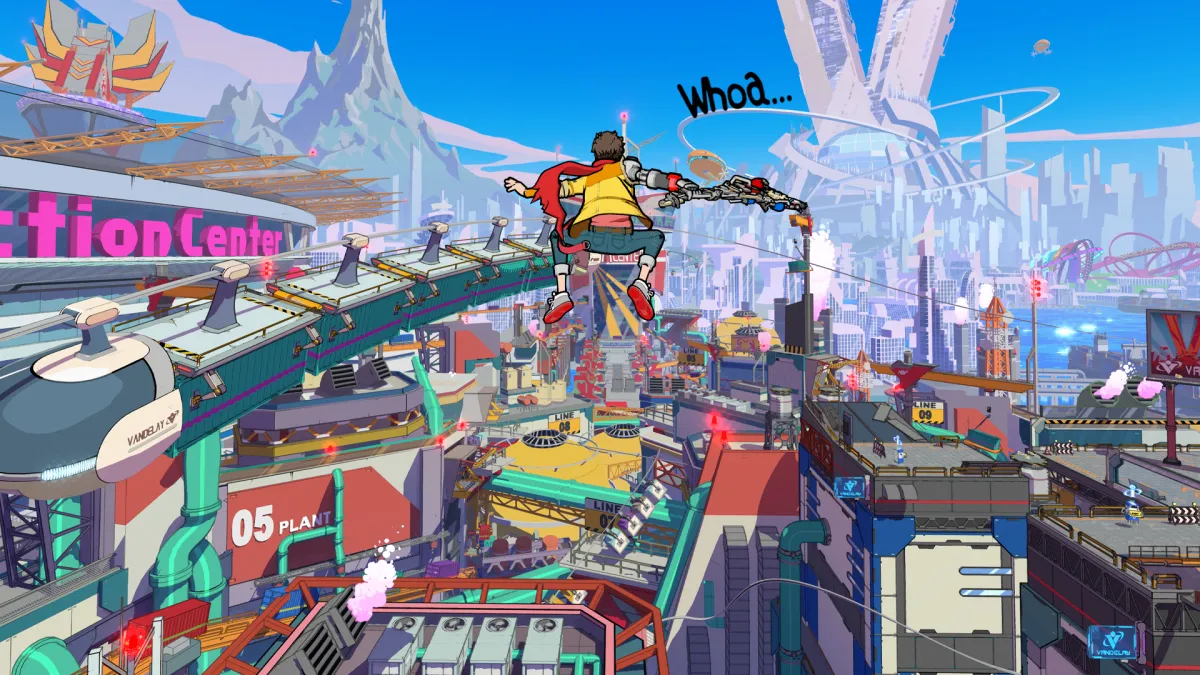★★★★☆
Like a much-loved song unexpectedly coming on in a club, Hi-Fi Rush’s sudden emergence is a truly welcome surprise. Given an abrupt, pre-release hype-free launch on 25 January, it’s a left-field title from Tango Gameworks – previously associated with dark opuses The Evil Within and Ghostwire Tokyo – and also unexpectedly brimming with ideas, passion and imagination. With any luck, word of mouth will see this disarming rhythm-action brawler find the audience it deserves.
Set in a dayglo metropolis where every element pulsates to a four-on-the-floor soundtrack, Hi-Fi Rush casts you as Chai, a cocksure twenty-something who’s turned into a kind of iPod-powered cyborg by the city’s corporate overlords, Vanderlay Technologies. With an MP3 player pounding in his chest and a robot arm clutching what looks like a makeshift Gibson Flying V, Chai fights off the city’s mechanical army, quickly joining forces with freedom fighter Peppermint and her cute artificial cat, 808.
Hi-Fi Rush plays like an affectionate remix of 2000s-era console games, its vibrant aesthetic recalling the likes of Space Channel 5, Jet Set Radio and Viewtiful Joe, while the combination of combat and 3D platforming is reminiscent of early Devil May Cry or mid-tier cult favourite, El Shaddai. Coincidentally, Metronomik’s more recent title, No Straight Roads, was another rhythm-action 3D game set in a colourful dystopia, though Hi-Fi Rush feels more polished and successful in its execution, even if the occasional frustration with camera placement and character positioning during the numerous platforming sections stands out as one of the more glaring flaws.

Hi-Fi Rush’s rhythm-based combat is an unexpected delight. Credit: Tango Gameworks/Bethesda.
Combat, meanwhile, is an almost unqualified triumph. Rather than punish the player for mistimed button presses, Hi-Fi Rush turns accuracy into a reward; executing attacks precisely in time to the beat increases the damage you deal and triggers additional special attacks. Any mistakes will result in longer battles (and therefore lower score rankings) and maybe a hit to your energy bar, but Hi-Fi Rush is fairly generous when it comes to dishing out life-boosting power-ups. Fights are therefore about striving for perfection rather than bare-knuckle survival.
Hi-Fi Rush also spaces out the various attacks and upgrades you receive. You’re taught how to perform simple attacks and combos first, before they’re joined by unlockable moves which you can ‘purchase’ and equip. A few minutes later, you’ll get a handy ranged attack you can use both in combat and while platforming; perhaps best of all, there’s a a grappling mechanic which allows you to rapidly traverse long distances. Before long, you’ll find yourself fending off smaller enemies with rapid-fire light attacks, using the grapple to haul yourself closer to a larger foe, and using a handful of carefully-timed presses to pull off a devastating charged attack.
It all feels fluid and remarkably intuitive, particularly given the range of attacks you can eventually acquire. The pace and fluidity makes pursuing the best possible rankings in each bout an absorbing pursuit.

Hi-Fi Rush’s world may be linear, but its design is so lively that it’s still a pleasure to journey through. Credit: Tango Gameworks/Bethesda.
The story that underpins the action is a lightweight affair, but it’s also surprisingly heartfelt at times; Chai and Peppermint bicker and point knowing barbs at the artificiality of the world they live in (“You’re starting to sound like a game tutorial!”), but it somehow feels less obnoxious than the similarly snarky Forspoken – perhaps because it’s so of a piece with the rest of the game’s frothy, anything-goes tone.
And in Hi-Fi Rush’s comic book world, just about anything does go. To a rock-heavy soundtrack that includes The Black Keys, Nine Inch Nails and The Joy Formidable, the game gleefully flits from combat to 3D platformer to on-rails action set-piece to 2D side-scroller. There are rooms full of hidden trinkets and huge, ridiculous boss battles that double as rhythm-action minigames. There are odd exchanges between little robot NPCs that are entirely incidental to the plot, but add colour to an already kaleidoscopic world.
If anything, there are times when Hi-Fi Rush is a little too busy, with the cel-shaded aesthetic sometimes making it tricky to pick out precisely where your jumps are going to take you – especially when you’re trying to land on a small, moving platform – or exactly where a ranged attack from a flying enemy came from.
The game’s clunkier elements – and there are few – are easily overlooked as your head nods to the beat and you successfully score an S-rank against yet another pack of enemies. At a time when so many mainstream games are going for bigger worlds and dramatic heft, it’s refreshing to find an experience that is so streamlined and unabashed in its eagerness to please. Like a great bubblegum pop song, Hi-Fi Rush wants nothing more than to thrill and entertain in the moment. It’s a groove that, once sampled, is difficult to resist.
Hi-Fi Rush is available now on Windows and Xbox Series X/S.




